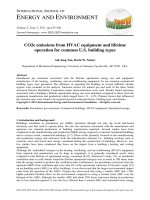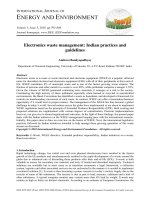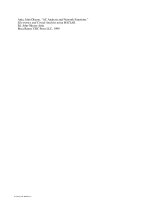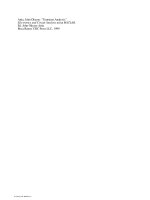Electricity and electronics for HVAC
Bạn đang xem bản rút gọn của tài liệu. Xem và tải ngay bản đầy đủ của tài liệu tại đây (5.85 MB, 405 trang )
Electricity and
Electronics
for HVAC
ABOUT THE AUTHOR
R
EX MILLER is Professor Emeritus of Industrial Technology at
the SUNY College at Buffalo. He has taught technical
curriculums at the high school, technical school, and college
levels for more than 40 years. Dr. Miller is the author or
coauthor of over 100 textbooks for vocational and industrial
arts programs, including McGraw-Hill’s best-selling
Carpentry and Construction and Electrician’s Pocket Manual.
M
ARK R. MILLER is Professor and Coordinator of Industrial
Technology at the University of Texas at Tyler. He has
taught technical curriculums at the high school, technical
school, and college levels for more than 25 years. Dr. Miller
is the author or coauthor of over 30 textbooks for trade and
technical programs, including McGraw-Hill’s Welding
Licensing Exam Study Guide and Air Conditioning and
Refrigeration.
Copyright © 2007 by The McGraw-Hill Companies, Inc. Click here for terms of use.
Electricity and
Electronics
for HVAC
Rex Miller
Professor Emeritus
State University College at Buffalo
Mark R. Miller
Professor
University of Texas at Tyler
New York Chicago San Francisco Lisbon London Madrid
Mexico City Milan New Delhi San Juan Seoul
Singapore Sydney Toronto
Copyright © 2007 by The McGraw-Hill Companies, Inc. All rights reserved. Manufactured in the United States of America. Except
as permitted under the United States Copyright Act of 1976, no part of this publication may be reproduced or distributed in any form
or by any means, or stored in a database or retrieval system, without the prior written permission of the publisher.
0-07-154270-1
The material in this eBook also appears in the print version of this title: 0-07-149668-8.
All trademarks are trademarks of their respective owners. Rather than put a trademark symbol after every occurrence of a trade-
marked name, we use names in an editorial fashion only, and to the benefit of the trademark owner, with no intention of infringe-
ment of the trademark. Where such designations appear in this book, they have been printed with initial caps.
McGraw-Hill eBooks are available at special quantity discounts to use as premiums and sales promotions, or for use in corporate
training programs. For more information, please contact George Hoare, Special Sales, at or (212)
904-4069.
TERMS OF USE
This is a copyrighted work and The McGraw-Hill Companies, Inc. (“McGraw-Hill”) and its licensors reserve all rights in and to the
work. Use of this work is subject to these terms. Except as permitted under the Copyright Act of 1976 and the right to store and
retrieve one copy of the work, you may not decompile, disassemble, reverse engineer, reproduce, modify, create derivative works
based upon, transmit, distribute, disseminate, sell, publish or sublicense the work or any part of it without McGraw-Hill’s prior con-
sent. You may use the work for your own noncommercial and personal use; any other use of the work is strictly prohibited. Your right
to use the work may be terminated if you fail to comply with these terms.
THE WORK IS PROVIDED “AS IS.” McGRAW-HILL AND ITS LICENSORS MAKE NO GUARANTEES OR WARRANTIES
AS TO THE ACCURACY, ADEQUACY OR COMPLETENESS OF OR RESULTS TO BE OBTAINED FROM USING THE
WORK, INCLUDING ANY INFORMATION THAT CAN BE ACCESSED THROUGH THE WORK VIA HYPERLINK OR OTH-
ERWISE, AND EXPRESSLY DISCLAIM ANY WARRANTY, EXPRESS OR IMPLIED, INCLUDING BUT NOT LIMITED TO
IMPLIED WARRANTIES OF MERCHANTABILITY OR FITNESS FOR A PARTICULAR PURPOSE. McGraw-Hill and its
licensors do not warrant or guarantee that the functions contained in the work will meet your requirements or that its operation will
be uninterrupted or error free. Neither McGraw-Hill nor its licensors shall be liable to you or anyone else for any inaccuracy, error
or omission, regardless of cause, in the work or for any damages resulting therefrom. McGraw-Hill has no responsibility for the con-
tent of any information accessed through the work. Under no circumstances shall McGraw-Hill and/or its licensors be liable for any
indirect, incidental, special, punitive, consequential or similar damages that result from the use of or inability to use the work, even
if any of them has been advised of the possibility of such damages. This limitation of liability shall apply to any claim or cause what-
soever whether such claim or cause arises in contract, tort or otherwise.
DOI: 10.1036/0071496688
We hope you enjoy this
McGraw-Hill eBook! If
you’d like more information about this book,
its author, or related books and websites,
please click here.
Professional
Want to learn more?
This book is dedicated to
Patricia Ann Navara Miller
A great Mother, Wife, and Educator
This page intentionally left blank
vii
Contents
Preface xvii
Acknowledgments xix
Chapter 1. Introduction to Electricity 1
Performance Objectives 1
Introduction to Electricity 1
Static Electricity and Magnetism 2
Electricity 2
Electricity’s Future 3
Matter and Electricity 4
Solids, gases, and liquids 4
Atom 5
Electrons, protons, and neutrons 6
Properties of Electrons 8
Orbiting Electrons 8
Electrical Charge 9
Outer Shell 10
Valence electrons and ions 10
A Practical Unit of Charge 12
The Volt 12
Controlling Electrons 13
Difference of Potential (Voltage) 13
Electron Flow (Current) 14
Conductors 14
Resistance 14
The Electric Circuit 15
Connecting a Circuit 16
Switches Control Electron Flow 16
Schematic 17
Review Questions 17
For more information about this title, click here
Chapter 2. Current, Voltage, Resistance, Power, and Ohm’s Law 19
Performance Objectives 19
Sources of Electricity 19
Chemical action 19
Heat 19
Light 20
Pressure 20
Magnetism 20
Units of Measurement 21
Unit of charge: coulomb 21
Unit of current: ampere 22
Unit of potential difference: volt 22
Unit of resistance: ohm 22
Siemens 23
Prefixes 23
Ohm’s Law 24
Ohm’s law examples 25
Ohm’s law and the closed circuit 27
Ohm’s law in other forms 29
Uses for ohm’s law 30
Power 31
Joule 31
Watt 32
Putting Electricity to Work 32
Resistors and heat 32
Mechanical energy 32
A Practical Unit of Electrical Power: Kilowatt-Hour 34
Review Questions 35
Chapter 3. Resistors, Other Electric Components,
and Their Symbols 37
Performance Objectives 37
Color Code 38
Tolerance 39
Examples 39
Gold and silver third bands 40
Variable Resistors 41
Schematic 43
Types of Resistors 43
Fixed resistors 43
Tapped resistors 44
Variable resistors 44
Fusible resistors 44
Temperature-compensating resistors 47
Types of Capacitors 47
Fixed capacitors 47
Electrolytic capacitors 48
Variable capacitors 49
Types of Inductors 50
Fixed inductors 50
Variable inductors 51
Transformers 51
viii Contents
Semiconductors 52
Diodes 52
Transistors 52
Switches 53
Relays 53
Fuses and Circuit Breakers 53
Lamps 55
Batteries 56
Meters 57
Reading Schematics 57
Review Questions 57
Chapter 4. Series and Parallel Circuits 59
Performance Objectives 59
Series Circuit 59
Resistances in series 61
Voltages in series 61
Current in series 61
Series circuit rules 62
Fuses 62
Parallel Circuit 63
Cells in parallel 63
Parallel circuit characteristics 63
Currents in a parallel circuit 64
Resistances in a parallel circuit 64
Parallel circuit rules 65
Series-Parallel Circuits 65
Series-parallel resistance circuits 66
Determining resistance 66
Determining current in series-parallel circuits 68
Determining voltage in series-parallel circuits 68
Review Questions 72
Chapter 5. Magnetism, Solenoids, and Relays 73
Performance Objectives 73
Permanent Magnets 74
Temporary Magnets 75
Electromagnets 75
Magnetic Theory 76
Magnetic Permeability 76
Shapes of Magnets 76
Poles of magnets 78
Electromagnetism 79
Magnetism in a coil of wire 80
Electromagnets 80
Using electromagnetism 82
The Solenoids and Relays 82
Power relays 86
Solenoid valves 86
Principles of operation 86
Applications 87
Liquid line service 87
Suction line service 89
Contents ix
High-Temperature Applications 89
Hot-gas defrost service 90
Transformers for Low-Voltage Controls 91
Review Questions 92
Chapter 6. Electrical Measuring Instruments 93
Performance Objectives 93
Electricity 93
Types of Meter Movements 94
D’Arsonval meter movement 94
Analog meters 97
Parallax Error 97
Ammeters 98
Extending the range of an ammeter 99
Connecting an ammeter in the circuit 99
Clamp-on ammeters 99
AC ammeters 101
Voltmeters 101
Connecting a voltmeter 102
AC Voltmeters 102
Ohmmeters 103
Multimeters 103
Meggers 104
Digital Meters 104
Other Instruments 106
Automatic halogen leak detector 106
Electronic sight glass 107
Electronic charging meters 107
Using an Ohmmeter 108
Warning 108
Adjusting the meter 108
Review Questions 110
Chapter 7. Electrical Power: Direct Current
and Alternating Current 111
Performance Objectives 111
Power Sources 111
Types of Batteries 112
Primary cell 112
Secondary cell 112
Dry Cells 112
Battery Specifications 115
Connecting Cells 115
Battery Maintenance 118
Nickel-Cadmium Cells 119
Alkaline Cells 119
Alternating Current 119
Sine Wave 120
Sine-Wave Characteristics 121
Phase 122
Average, RMS, and Peak Values of AC 122
x Contents
ebooksdownloadrace.blogspot.in
Polyphase Alternating Current 123
Three phase 124
Three-phase connections 124
Electrical Properties of Delta and Wye 126
Delta connection (⌬) 126
Wye connection (Y) 126
Delta and wye summarized 126
Review Questions 127
Chapter 8. Inductors and Transformers 129
Performance Objectives 129
Changing Inductance 130
Self-Inductance 130
Mutual Inductance 133
Inductive Reactance 134
Measuring X
L
134
Power in an Inductive Circuit 134
Uses for Inductive Reactance 135
Transformers 135
Mutual inductance in a transformer 135
Iron-core transformer 136
Construction 137
Types of iron-core transformers 137
Voltage Transfer 138
Step up, step down 139
Turns ratio 139
Power Transformers 140
Audio Frequency and Radio Frequency Transformers 140
Autotransformers 141
Transformer Losses 142
Inductive Circuits 144
Special handling 145
Utilizing the Inductive Delay 146
Review Questions 146
Chapter 9. Capacitors and Capacitive Reactance 147
Performance Objectives 147
The Capacitor 149
How the Capacitor Works 149
Capacity of a Capacitor 150
Breakdown Voltage 151
Basic Units of Capacitance 151
Types of Capacitors 151
Electrolytic Capacitors 153
Making an electrolytic capacitor 154
Connecting electrolytics 154
Working Voltage, Direct Current (WVDC) 155
Capacitive Reactance 155
Capacitor Causes a Lagging Voltage 156
Checking Capacitors 157
Review Questions 158
Contents xi
xii Contents
Chapter 10. Single-Phase and Three-Phase Alternating Current 161
Performance Objectives 161
Single-Phase and Three-Phase AC 161
Resistance, Capacitance, and Inductance 162
Power Factor 164
Distributing Electric Power 165
Polyphase 166
Circuit Breakers 169
Review Questions 171
Chapter 11. Solid-State Controls 173
Performance Objectives 173
Semiconductors 173
Semiconductor Principles 174
Diode 175
Silicon-Controlled Rectifiers 177
Transistors 178
Transistor impedances 179
Integrated Circuits 180
Solid-state demand defrost control 182
Thermistor Sensing 182
Humidity Sensing 184
Bridge Circuit 186
Unbalanced bridge 187
Sensors 189
Controllers 189
Electronic Controllers 189
Differential Amplifiers 190
Actuators 191
Other Devices 192
Solid-State Compressor Motor Protection 192
Operation of the module 192
Troubleshooting the control 194
Restoring service 196
Review Questions 197
Chapter 12. Alternating Current Motors 199
Performance Objectives 199
Motors 199
Split-Phase Motor 204
Getting the motor started 204
Repulsion Start, Induction Run Motor 206
Capacitor-Start Motor 208
Permanent Split-Capacitor Motor 210
Theory of operation 212
Capacitor-Start, Capacitor-Run Motor 215
Theory of operation 215
Three-Phase Motor 216
Theory of operation 216
Capacitor Ratings 219
Start Capacitors and Bleeder Resistors 219
Run capacitors 221
Motor Protectors 221
Compressor Motor Relays 221
Current-type relay 222
Potential-type relay 222
Review Questions 224
Chapter 13. Electrical Safety 225
Performance Objectives 225
Safety Devices 225
Safety Precautions 225
Main Switches 226
Portable Electrical Tools 227
Ground-Fault Circuit Interrupters (GFCI) 229
Types of Circuit Protectors 230
Review Questions 231
Chapter 14. Control Devices 233
Performance Objectives 233
Power Relays 233
Motor start relays 234
Relays with more than one contact 235
Thermal overload protectors 236
Time-delay relays 237
Solenoids 238
Thermostats 239
Bellows-type thermostats 239
Bimetallic-type thermostats 241
Heating and cooling thermostats 242
Microprocessor thermostats 245
Thermostat Adjustments 245
Heat anticipators 246
Cold anticipators 246
Switches of Many Types 246
Pressure Control Switches 247
Water Tower Controls 248
Review Questions 250
Chapter 15. Heating Circuits 251
Performance Objectives 251
Basic Gas Furnace Operation 252
Basic Electric Heating System 253
Basic operation 253
Ladder Diagrams 254
Manufacturer’s Diagrams 257
Field Wiring 258
Low-Voltage Wiring 258
Contents xiii
Heat Pumps 260
Operation 261
Special requirements of heat-pump systems 266
Heat-pump combinations 267
High-Efficiency Furnaces 267
Operation 268
Electrical controls 269
Sequence of operation 270
Combustion process 271
Troubleshooting the Pulse Furnace 271
Review Questions 278
Chapter 16. Air-Conditioning Circuits 279
Performance Objectives 279
Basic Air-Conditioning Unit 279
Push-button switches 282
Fans 283
Schematics 283
Ladder Diagrams 287
Thermostats 287
Fan switches 291
Troubleshooting 291
Review Questions 291
Chapter 17. Refrigeration Circuits 293
Performance Objectives 293
Basic Refrigerator 293
Thermostats 293
Start relays 295
Refrigerator-Freezer Combination 295
Manual defrost 295
Automatic defrost 296
Defrosting 296
Defrost thermostats 297
Defrost cycle 299
Other Devices 302
Troubleshooting 304
Rapid Electrical Diagnosis 306
Energy-Saver Switches 309
Review Questions 310
Chapter 18. Troubleshooting 311
Performance Objectives 311
Safety 311
Handling refrigerants 312
Testing precaution 312
Electrical safety 312
Compressor Problems 312
PSC compressors 312
Air-conditioner compressors 312
xiv Contents
Low-Voltage Operation 315
Using a System to Troubleshoot (Electrical) 316
Motor testing 316
Capacitor testing 317
Motor-protector relay testing 317
Using Meters to Check for Problems 318
Using a Volt-Ammeter for Troubleshooting Electric Motors 320
Clamp-on volt-ammeters 320
Looking for grounds 321
Looking for opens 322
Looking for shorts 322
Motors with Squirrel-Cage Rotors 323
Testing the Centrifugal Switch in a Single-Phase Motor 323
Testing for a Short Circuit Between Run and Start Windings 324
Capacitor testing 324
Measuring the capacity of a capacitor 325
Troubleshooting Procedure 326
Review Questions 327
Chapter 19. Controlling Electrical Power for
Air-Conditioning Units 329
Performance Objectives 329
Choosing Wire Size 329
Limiting voltage loss 330
Minimum wire size 330
Wire selection 330
Wire Size and Low Voltage 330
Voltage drop calculations 332
The Effects of Voltage Variations on AC Motors 333
Selecting Proper Wire Size 335
Unacceptable Motor Voltages 336
Calculating Starting Current Values and Inrush Voltage Drops 336
Single-phase current 336
Three-phase circuits 338
Inrush voltage drop 339
Code Limitations on Amperes Per Conductor 339
Heat Generated Within Conductors 339
Circuit Protection 340
Standard rule 341
Fuses 341
One-time single-element fuses 341
Time-delay two-element fuses 342
Types of fuses 343
Thermostats 343
Thermostat as a control switch 344
Service 345
Starter Kits 346
Single-Phase Line Monitors 347
Time Delays 350
Pressure Controls 350
Head pressure controls 350
Line voltage head pressure controls 352
Contents xv
Three-Phase Line Voltage Monitor 355
Current Sensing 355
Review Questions 359
Chapter 20. Careers in Air Conditioning and Refrigeration 361
Performance Objectives 361
Industries that Employ Air-Conditioning and Refrigeration Mechanics 361
Job Qualifications 364
The Future 365
Pay and Benefits 365
Teaching as a Career 367
Sources of Additional Information 367
Review Questions 369
Index 371
xvi Contents
xvii
Preface
This book is intended to provide an introduction to the basic principles of elec-
tricity and electronics as they apply to refrigeration, heating, and air-
conditioning systems. It combines basic principles, using very little math, with
the latest applications found in the HVAC industry.
The fields of refrigeration, air conditioning, and heating are undergoing some
very rapid changes. The advent of the computer chip has made it possible to con-
trol heating and cooling systems precisely and with a great deal of freedom in
programming their applications. The new high-efficiency furnaces utilize the
chip both for sequencing and for protection from accidental damage. Most
of these programmable controllers provide instructions and technical bulletins.
They are numerous, and each has its own approach to solving a given problem.
This book will make it possible for you to understand these instructions and
improvements.
Future technicians need to deal with the fact that change is inevitable, and
that they will have to keep up with the latest developments as long as they work
in the field. It is hoped that this book will make that task easier.
REX MILLER
MARK R. MILLER
Copyright © 2007 by The McGraw-Hill Companies, Inc. Click here for terms of use.
This page intentionally left blank
Acknowledgments
No author works without being influenced and aided by others, and this book
is no exception. A number of people cooperated in providing technical data and
illustrations, and for this we are grateful. We would like to thank those organ-
izations that so generously contributed information and illustrations. The follow-
ing have been particularly helpful:
Amprobe Instrument Division of SOS Consolidated, Inc.
Carrier Corporation
Eveready Division of Union Carbide
General Controls
General Electric Company
Honeywell, Inc.
Kelvinator Appliance Company
Lennox Industries (Toronto, Canada)
National Safety Council
Robert Shaw Controls Company
Sporlan Valve Company
Tecumseh Products Company
Tyler Refrigeration Corporation
Wadsworth Electric Company
Wagner Electric Company
Westinghouse Electric Company
Weston Electrical Instruments Company
R
EX
MILLER
M
ARK
R. MILLER
xix
Copyright © 2007 by The McGraw-Hill Companies, Inc. Click here for terms of use.
This page intentionally left blank
Electricity and
Electronics
for HVAC
This page intentionally left blank
Chapter
1
Introduction to Electricity
Performance Objectives
■
Understand how matter and electricity are related.
■
Understand how liquids, solids, and gases are similar, yet different.
■
Understand how atoms, electrons, protons, and neutrons are all related to the
production of electricity.
■
Understand how electricity is put to work in the electric circuit.
■
Understand how switches control the flow of electricity.
Introduction to Electricity
Electricity is as old as the universe. But knowledge about it is relatively new.
Early humans were aware of electricity in the form of lightning. They learned
of its power when they saw it starts fires and kills people and animals. But it was
only about 300 years ago that people began to learn the basic laws of electric-
ity. And only about 120 years have passed since electricity was first put to work.
It has been only 100 years since the first practical electric lamp was invented,
only 80 years since the vacuum tube was invented, and less than 40 years since
the transistor was invented. Despite this brief time, electricity has greatly
changed people’s lives—our lives.
The universe consists of atoms and every atom contains at least one electron.
An electron is the smallest particle of an atom and has a negative electric
charge. When the movement of electrons is controlled, they are capable of
doing work.
1
Copyright © 2007 by The McGraw-Hill Companies, Inc. Click here for terms of use.









